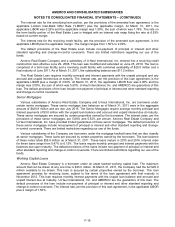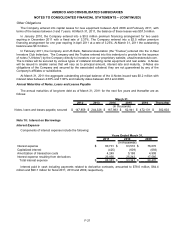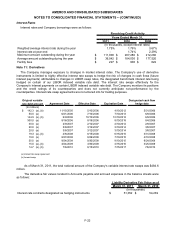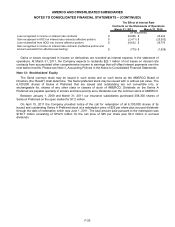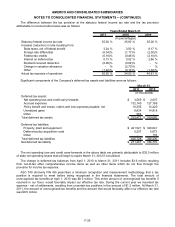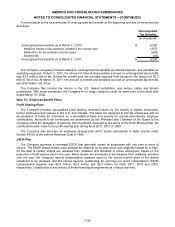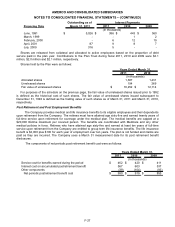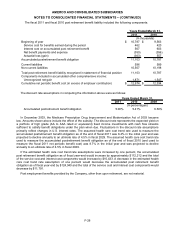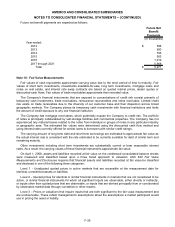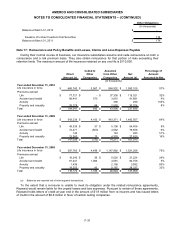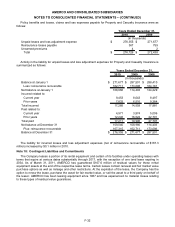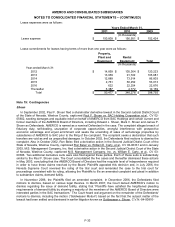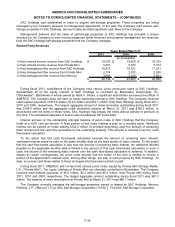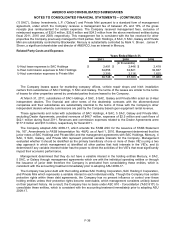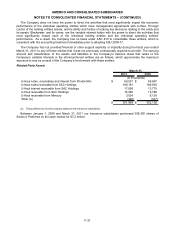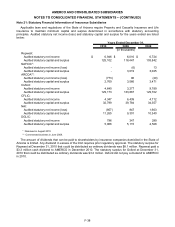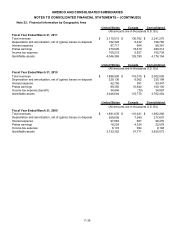U-Haul 2011 Annual Report Download - page 85
Download and view the complete annual report
Please find page 85 of the 2011 U-Haul annual report below. You can navigate through the pages in the report by either clicking on the pages listed below, or by using the keyword search tool below to find specific information within the annual report.
AMERCO AND CONSOLIDATED SUBSIDIARIES
NOTES TO CONSOLIDATED FINANCIAL STATEMENTS -- (CONTINUED)
96
71
Future net benefit payments are expected as follows:
Future Net
Benefit
Payments
(In thousands)
Year-ended:
2012 $5
2013 690
2014 795
2015 903
2016 1,019
2017 through 2021 5,968
Total $9,9
Note 16: Fair Value Measurements
Fair values of cash equivalents approximate carrying value due to the short period of time to maturity. Fair
values of short term investments, investments available-for-sale, long term investments, mortgage loans and
notes on real estate, and interest rate swap contracts are based on quoted market prices, dealer quotes or
discounted cash flows. Fair values of trade receivables approximate their recorded value.
The Company’s financial instruments that are exposed to concentrations of credit risk consist primarily of
temporary cash investments, trade receivables, reinsurance recoverables and notes receivable. Limited credit
risk exists on trade receivables due to the diversity of our customer base and their dispersion across broad
geographic markets. The Company places its temporary cash investments with financial institutions and limits
the amount of credit exposure to any one financial institution.
The Company has mortgage receivables, which potentially expose the Company to credit risk. The portfolio
of notes is principally collateralized by self-storage facilities and commercial properties. The Company has not
experienced any material losses related to the notes from individual or groups of notes in any particular industry
or geographic area. The estimated fair values were determined using the discounted cash flow method and
using interest rates currently offered for similar loans to borrowers with similar credit ratings.
The carrying amount of long term debt and short term borrowings are estimated to approximate fair value as
the actual interest rate is consistent with the rate estimated to be currently available for debt of similar term and
remaining maturity.
Other investments including short term investments are substantially current or bear reasonable interest
rates. As a result, the carrying values of these financial instruments approximate fair value.
On April 1, 2008, assets and liabilities recorded at fair value on the condensed consolidated balance sheets
were measured and classified based upon a three tiered approach to valuation. ASC 820 Fair Value
Measurements and Disclosures requires that financial assets and liabilities recorded at fair value be classified
and disclosed in one of the following three categories:
Level 1 - Unadjusted quoted prices in active markets that are accessible at the measurement date for
identical, unrestricted assets or liabilities;
Level 2 – Quoted prices for identical or similar financial instruments in markets that are not considered to be
active, or similar financial instruments for which all significant inputs are observable, either directly or indirectly,
or inputs other than quoted prices that are observable, or inputs that are derived principally from or corroborated
by observable market data through correlation or other means;
Level 3 – Prices or valuations that require inputs that are both significant to the fair value measurement and
are unobservable. These reflect management’s assumptions about the assumptions a market participant would
use in pricing the asset or liability.
F-29


